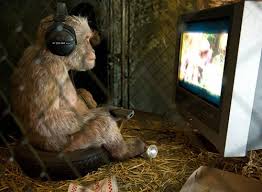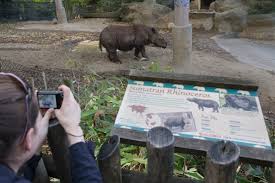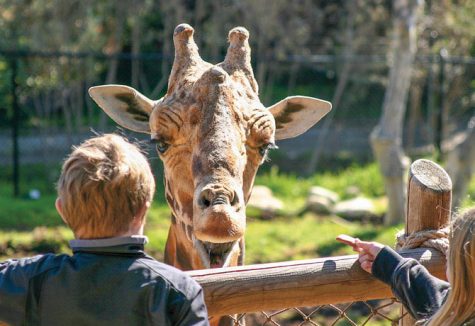Zoos: Are they ethical?

Zoos have been, for a long time, a highly-controversial subject. Are zoos ethical? Should animals be taken out of their natural habitats to sit in cages all day long? There are mixed ideas, however, after doing some research and hearing from both the Cleveland Metroparks Zoo and the Akron Zoo, I believe that zoos are ethical.

One of the main aspects of this idea is that the animal enclosures are an inadequate replacement for the animals’ natural habitats. The animals are placed inside of enclosures, where zoos attempt to make the enclosures very much like the animals’ natural habitat. Akron Zoo head of education department Autumn Russel says, “We work to create habitats that meet their needs.” An example of this can be seen in Akron Zoo’s Snow Leopard enclosure, where the leopards Shanti and Tai move up and down the mountain cliffs, similar to what the animals would do in their natural habitats.
Mr. Face, teacher at Mayfield Middle School, says that “if the zoos produce an environment that allows the animals to thrive and they are not caged up it, it makes it better.” Personally, I also believe this to be true, as seen in many of the enclosures in the local zoos.
Alongside this, many animals that are contained in zoos were actually born inside of zoos, so even if there was a movement to have animals released into the wild, the chance that they would survive would be very slim. They are fed by zoo employees and do not know how to hunt. Cleveland Zoo offers complete disclosure about their feeding practices. On their site, patrons can look up each animal and see what their wild diet would be in comparison to their zoo diet. In many cases, there is considerable crossover.
 Some critics of zoos worry about the animals’ mental health. Many believe that animals are forced to stay inside enclosures and do the same acts, over and over again. However, zookeepers provide animals with activities to stimulate them mentally and physically. These activities can be called enrichment, like at Akron Zoo. In Akron Zoo, during the day, the activities that each animal undergoes fall under 1 of 4 categories: sensory, occupational, social, and human interactions. These activities could include watching TV, a zookeeper reading a book to an animal, and activities that would enhance the abilities related to the specific species.
Some critics of zoos worry about the animals’ mental health. Many believe that animals are forced to stay inside enclosures and do the same acts, over and over again. However, zookeepers provide animals with activities to stimulate them mentally and physically. These activities can be called enrichment, like at Akron Zoo. In Akron Zoo, during the day, the activities that each animal undergoes fall under 1 of 4 categories: sensory, occupational, social, and human interactions. These activities could include watching TV, a zookeeper reading a book to an animal, and activities that would enhance the abilities related to the specific species.
At Cleveland Metroparks Zoo, Rochelle LeMaster, says that “Animals receive the highest level of animal care including feedings, vet appointments, and enrichment activities.”

Some believe that being enclosed causes stress in the animals. Like humans, animals can become paranoid and stressed when spending time enclosured. Signs of stress include pacing back and forth and biting the bars of cages. Along with that, abnormal, repetitive acts can be seen in animals, also showing signs of stress. Bears in particular are often seen pacing at zoos with the ground worn as evidence of their repetitive behaviors. However, I believe that if a zoo takes an animals’ care seriously, then the animals will be occupied and engaged in activities that will make the animals’ lives better.
Despite this evidence, critics still believe that zoos are unhealthy for animals. However, they must understand that zoos and zookeepers are fond of what they do. The purpose of zoos is not purely to entertain, but to educate the visitors of each exhibit and to help endangered species thrive. In fact , the American Zoological Association has a whole project called SAFE, or saving animals from extinction. The project allows endangered species to thrive in specially built places, implements “strategic conservation and stakeholder engagement activities,” builds on established recovery plans and history of commitment, and much more.
, the American Zoological Association has a whole project called SAFE, or saving animals from extinction. The project allows endangered species to thrive in specially built places, implements “strategic conservation and stakeholder engagement activities,” builds on established recovery plans and history of commitment, and much more.
Rocco DiPietro, eighth grader at Mayfield Middle Schools says that “Zoos are good because they help endangered species.” This is what SAFE does, and it is hoping to expand the number of endangered species that are being helped around the world.
Along with this, zoos help educate people around the world about endangered species and species of animals in general, and how they can help out with the matter. Curtis Bates, an eighth grader, says that “Zoos are fun places for to kids to learn about animals.” It is the hope of zoos that by gaining familiarity with animals through the exhibits that humans continue to gain empathy for animals and therefore contribute to their care.
Zoos can also act as a rehabilitation center for injured animals who would not at all be able to survive in their natural habitat.

Regarding an overproduction problem that is said to occur in zoos, it is true that some animals are killed due to a high population of that species of animal. However, practices like this are on the decline due to better planning and communication among zoos across the nation. Akron Zoo, for example, carefully plans their reproduction in animals, and therefore protects animals.
Zoos, despite the hate, are incredible places where kids can learn about animals, or where zookeepers can fulfill their dreams of helping endangered animals. Zoos, despite everything that is said about them, are ethical.






